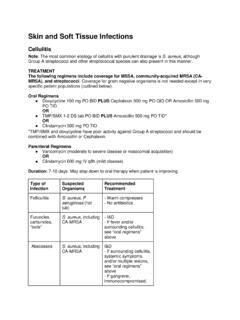Transcription of Prevention of Perinatal Group B Streptococcal Disease
1 Morbidity and Mortality Weekly Report Recommendations and Reports November 19, 2010 / Vol. 59 / No. RR-10. Prevention of Perinatal Group B. Streptococcal Disease Revised Guidelines from CDC, 2010. Continuing Education Examination available at http://w department of health and human services Centers for Disease Control and Prevention MMWR Contents The MMWR series of publications is published by the Office of Surveillance, Epidemiology, and Laboratory Services, Centers for 1. Disease Control and Prevention (CDC), Department of Health 2.
2 And Human Services, Atlanta, GA 30333. Suggested Citation: Centers for Disease Control and Prevention . Invasive Group B Streptococcal 3. [Title]. MMWR 2010;59(No. RR-#):[inclusive page numbers]. Prevention of Early-Onset Group B Streptococcal 4. Identification of Candidates for Intrapartum Antibiotic 6. Centers for Disease Control and Prevention Specimen Collection and Processing for GBS 7. Thomas R. Frieden, MD, MPH. Director Secondary Prevention of Early-Onset GBS Among 10. Harold W. Jaffe, MD, MA Implementation and Impact of GBS Prevention 11.
3 Associate Director for Science 14. James W. Stephens, PhD. Office of the Associate Director for Science Future of GBS 23. Stephen B. Thacker, MD, MSc 23. Deputy Director for Surveillance, Epidemiology, and Laboratory Services Stephanie Zaza, MD, MPH. Director, Epidemiology Analysis and Program Office Editorial and Production Staff Ronald L. Moolenaar, MD, MPH. Editor, MMWR Series Christine G. Casey, MD. Deputy Editor, MMWR Series Teresa F. Rutledge Managing Editor, MMWR Series David C. Johnson Lead Technical Writer-Editor Jeffrey D.
4 Sokolow, MA. Project Editor Martha F. Boyd Lead Visual Information Specialist Malbea A. LaPete Stephen R. Spriggs Terraye M. Starr Visual Information Specialists Quang M. Doan, MBA. Phyllis H. King Information Technology Specialists Editorial Board William L. Roper, MD, MPH, Chapel Hill, NC, Chairman Virginia A. Caine, MD, Indianapolis, IN. Jonathan E. Fielding, MD, MPH, MBA, Los Angeles, CA. David W. Fleming, MD, Seattle, WA. William E. Halperin, MD, DrPH, MPH, Newark, NJ. King K. Holmes, MD, PhD, Seattle, WA. Deborah Holtzman, PhD, Atlanta, GA.
5 John K. Iglehart, Bethesda, MD. Dennis G. Maki, MD, Madison, WI. Patricia Quinlisk, MD, MPH, Des Moines, IA. Patrick L. Remington, MD, MPH, Madison, WI. Barbara K. Rimer, DrPH, Chapel Hill, NC. John V. Rullan, MD, MPH, San Juan, PR Disclosure of Relationship William Schaffner, MD, Nashville, TN CDC, our planners, and our content experts wish to disclose they have Anne Schuchat, MD, Atlanta, GA. Dixie E. Snider, MD, MPH, Atlanta, GA. no financial interests or other relationships with the manufacturers of John W. Ward, MD, Atlanta, GA commercial products, suppliers of commercial services, or commercial supporters.
6 Presentations will not include any discussion of the unla- beled use of a product or a product under investigational use. Vol. 59 / RR-10 Recommendations and Reports 1. Prevention of Perinatal Group B Streptococcal Disease Revised Guidelines from CDC, 2010. Prepared by Jennifer R. Verani, MD. Lesley McGee, PhD. Stephanie J. Schrag, DPhil Division of Bacterial Diseases, National Center for Immunization and Respiratory Diseases Summary Despite substantial progress in Prevention of Perinatal Group B Streptococcal (GBS) Disease since the 1990s, GBS remains the leading cause of early-onset neonatal sepsis in the United States.
7 In 1996, CDC, in collaboration with relevant professional soci- eties, published guidelines for the Prevention of Perinatal Group B Streptococcal Disease (CDC. Prevention of Perinatal Group B. Streptococcal Disease : a public health perspective. MMWR 1996;45[No. RR-7]); those guidelines were updated and republished in 2002 (CDC. Prevention of Perinatal Group B Streptococcal Disease : revised guidelines from CDC. MMWR 2002;51[No. RR-11]). In June 2009, a meeting of clinical and public health representatives was held to reevaluate Prevention strategies on the basis of data collected after the issuance of the 2002 guidelines.
8 This report presents CDC's updated guidelines, which have been endorsed by the American College of Obstetricians and Gynecologists, the American Academy of Pediatrics, the American College of Nurse- Midwives, the American Academy of Family Physicians, and the American Society for Microbiology. The recommendations were made on the basis of available evidence when such evidence was sufficient and on expert opinion when available evidence was insufficient. The key changes in the 2010 guidelines include the following: expanded recommendations on laboratory methods for the identification of GBS, clarification of the colony-count threshold required for reporting GBS detected in the urine of pregnant women, updated algorithms for GBS screening and intrapartum chemoprophylaxis for women with preterm labor or preterm pre- mature rupture of membranes, a change in the recommended dose of penicillin-G for chemoprophylaxis, updated prophylaxis regimens for women with penicillin allergy.
9 And a revised algorithm for management of newborns with respect to risk for early-onset GBS Disease . Universal screening at 35 37 weeks' gestation for maternal GBS colonization and use of intrapartum antibiotic prophylaxis has resulted in substantial reductions in the burden of early-onset GBS Disease among newborns. Although early-onset GBS Disease has become relatively uncommon in recent years, the rates of maternal GBS colonization (and therefore the risk for early-onset GBS. Disease in the absence of intrapartum antibiotic prophylaxis) remain unchanged since the 1970s.
10 Continued efforts are needed to sustain and improve on the progress achieved in the Prevention of GBS Disease . There also is a need to monitor for potential adverse consequences of intrapartum antibiotic prophylaxis ( , emergence of bacterial antimicrobial resistance or increased incidence or severity of non-GBS neonatal pathogens). In the absence of a licensed GBS vaccine, universal screening and intrapartum antibiotic prophylaxis continue to be the cornerstones of early-onset GBS Disease Prevention . Introduction colonization with GBS in the genitourinary or gastrointestinal tracts is the primary risk factor for Disease .










